Banksia grandis



Fissured or Wrinkled
Fissured bark forms long narrow divisions causing separations. Wrinkled bark generally has smooth folded appearance that may be warty.
Narrow domed
A tree or shrub with a narrow rounded outline.This large shrub to small tree has a thick grey wrinkly bark and spreading branches that form a rounded crown. It has glossy dark green lobed leaves and the pale yellow flowers appear in a cylindrical spike amongst the foliage from late spring to early summer.
Banksia grandis Willd. is naturally found in south-west Western Australia from Mt Lesueur to Cape Leeuwin and inland to Wooddanilling. It grows in coastal heath and woodlands and is commonly seen in the Jarrah forests of the Darling Plateau, appearing from sea level to an altitude of 250 m (820 ft) or more. It grows in poor to moderately fertile white or grey sandy-stony and light loamy soil that is tending acidic with a pH range from 5.5 to 6.5. It prefers an open sunny position but will tolerate some shade and is drought and light frost tolerant once established with a preferred minimum winter temperature of 7.2ºC (45ºF). It re-shoots after fire from epicormic buds.
The Bull Banksia is grown for its yellow flower heads and its toothed foliage. It is planted in parks and botanical collections as a specimen or in group plantings along borders to attract birds. It is also used in woodland settings or coastal positions preferring a Mediterranean climate (low humidity). It is suitable for inland regions and has a moderate growth rate, establishing in 3-5 years and is long-lived. Once established it has a low water requirement (Scale: 1-drop from 3), preferring to have dry surface soil before watering as the plant rots easily in wet soils.
ID 13
UK hardiness zone H2
Climate zones 15 - 24, H1
USDA Zone 9-10
Banksia (BANK-see-a) grandis (GRAN-dees)
Etymology
Genus:- - Banksia – Named after Sir Joseph Banks
Species: Latin - grandis – meaning “great” – referring to the large leaves

Australia (south west Western Australia)
Proteaceae (pro-tee-AY-see-ee)
Protea Family
Distribution
This family of dioecious or monoecious trees and shrubs mainly appear in the southern hemisphere with some found in Central America and Africa. They are abundant in the southern part of Australia and normally grow on poor infertile soils that are tending acidic. Their habitats include shrubland, grassland, rainforests, alpine meadows and tropical lowlands
Diagnostic Features
The highly variable leaves are arranged alternate, opposite or whorled and are compound, dissected or lobed or pinnately toothed or simple. The margin is entire or pinnatisect and without stipules. The leaf shape can vary at different stages of growth, juvenile to adult.
The normally bisexual flowers are regular or irregular, arranged in racemes or compound inflorescences (cone-like); some are solitary and appear in the leaf axils.
There are normally 4-perianth-segments that are free or united and are arranged in a single whorl, petaloid and valvate in bud joined when young and separating as the tube splits down one side.
The 4-stamens are all fertile and appear opposite the perianth segments and may be reduced to staminodes.
The filaments are partly or wholly attached to the tepals often sessile and the anthers are four chambered opening with longitudinal slits.
The ovary is superior and has one carpel that contains one chamber with one to many ovules.
The hooked style is simple and the stigma is small bulbous (capitate) or maybe bilobed.
The fruit are dehiscent or indehiscent follicle or drupe or achene with few or many winged seeds.
Note:
Some species are used for food, alcoholic drink, herbal remedies and extensively used in ornamental and domestic gardens for their fantastic flowers and foliage. There are 80 genera and 1,700 species.
This plant tolerates between USDA zones 9a to 10a and grows to 10 m (32 ft)
Fahrenheit 20º to 30º F
These temperatures represent the lowest average.
Celsius -6.6º to -1.1º C

Attention
This plant was last revised on the 17/11/2020
The information displayed on this plant is based on research conducted in our horticultural library and from reliable online resources. We also make observations of the plant that we photograph, and all care is taken to ensure the details are correct.
All photographs and data are covered by copyright. Apart from any fair dealing for the purpose of private study, research, reference or review, as permitted under the Copyright Act, no part including images and text may be reproduced by any means without written permission. The information presented in the map is only indicative and may contain errors and omissions. All inquiries should be addressed to sales@plantfile.com attention Peter Kirkland.

Simple
The leaf that is not divided.
Obovate
A leaf that is broadest at the apex tapering towards the base.
Alternate
Leaves are arranged alternately along the stem.
Dentate
A (saw toothed) margin when it is deeply indented at regular intervals.The flat leathery textured glossy dark green narrow obovate leaves are up to 310 mm (12 in) long by 100 mm (4 in) wide and have large triangular lobes that are divided to the mid-rib. The apex is truncate and the base is cuneate with a petiole up to 25 mm (1 in) long. The upper surface is covered in tomentose then becoming glabrous with age and the underside is covered in fine woolly grey tomentum.

Tubulate
A flower that forms a tube shape.
Spike
It is an unbranched inflorescence with sessile flowers (a simple raceme).| Jan | Feb | Mar | Apr | May | Jun |
| Jul | Aug | Sep | Oct | Nov | Dec |
The pale yellow tubulate flowers have straight pubescent perianth segments that are up to 35 mm (1 3/8 in) long and a pistil to 40 mm (1 5/8 in) long. They are arranged in a upright cylindrical spike that is up to 400 mm (16 in) tall by 90 mm (3 ½ in) in diameter and appear terminally on short 1 year old branchlets from late spring to early summer.
Note:
Generally Banksia flower spikes are composed of hundreds of small individual tubular flowers (florets) that are densely arranged around a single cylindrical axis.

Follicle
A capsular fruit that splits open down one side only and normally contains one seeds. "| Jan | Feb | Mar | Apr | May | Jun |
| Jul | Aug | Sep | Oct | Nov | Dec |
There are many elliptical follicles that are up to 25 mm (1 in) long by 10 mm (3/8 in) high and 12 mm (½ in) wide. The wrinkly valves open when mature releasing the seeds and are embedded in a large cone like cluster. The obovate seeds are up to 16 mm (2/3 in) long by 9 mm (3/8 in) wide and flattened (not notched) wing is up to 20 mm (¾ in) wide.
Note:
The seeds are released when the follicles are mature and are not reliant on fire.
The Bull Banksia is grown for its yellow flower heads and its toothed foliage. It is planted in parks and botanical collections as a specimen or in group plantings along borders to attract birds. It is also used in woodland settings or coastal positions preferring a Mediterranean climate (low humidity). It is suitable for inland regions and has a moderate growth rate establishing in 3-5 years and as a long-lived.
Note:
The Bull Banksia is very difficult to grow in regions that have a hot humid summer where it suffers from a dieback.
General pruning information
When pruning reduce only the new growth as cutting old wood is likely to cause dieback. Limbs may be removed back to the collar.
Cultivation
Generally, Banksia species prefer a well drained, sandy soil that is tending acidic but many species from Western Australia grow on acidic top soils with alkaline subsoil. When the growing Western Australian species outside their native habitat technique of building a garden bed, of acidic soil above a layer of agricultural lime commonly produces better results particularly in raised garden beds or on slopes. During establishment, keep the soil moist but not wet and do not use fertiliser that contains phosphorus.
Fresh seed should be sown in a well-drained media and the kept moist but not wet. Maintain a temperature of 18º to 21º C. (64º to 75º F) in an unheated glasshouse or open frame. Germination occurs within 3 weeks to 3 months depending on the species, then prick out and pot up. Careful not to over water seedlings, as they are prone to damping off and larger plants are difficult to transplant. When removing seed from Banksia fruits it may be necessary to place the fruit in an oven for 60 minutes at a temperature of 120° C. to simulating the effect of a bushfire to opening the valves.
Note:
The seeds of the species require no pretreatment and germinate within 22 to 42 days.
Propagation by Seed (General)
Germination
In order for a seed to germinate it must fulfil three conditions.
1. The embryo must be alive (a viable seed).
2. The seed must have no dormancy-inducing physiological, physical or chemical barrier to germination; also the seed must be nondormant.
3. The seed must have the appropriate environmental requirements, water, temperature and oxygen.
The interaction between these requirements and dormancy is complex and may lead to different environmental requirements that avoid the dormancy of a seed.
Sowing Seeds in Containers
There are two general methods for germinating seeds.
Seeds in a flat or germinating bed, through which seedlings are pricked-out then, transplanted into another flat with wider spacing or directly to an individual pot.
2. Sowing seeds by placing them in to flats with the appropriate spacing or into individual pots.
This method is normally carried out with medium to large seeds such as woody plants and plants that are difficult to transplant.
Seedling production normally occurs in a greenhouse / glasshouse, cold frames and on hot beds.
Method of Seed Sowing
Fine seed is sown in pots or flats that are no deeper than 70 to 80 mm. using a sterilised well-drained media (soil). Fill the container to 20 mm from the top and sprinkle sieved peat to 3 mm depth.
Press the media down level and firm with a piece of timber and then thoroughly moisten.
Mix the fine seed with washed sand and then sow thinly on the surface. These may be lightly covered with sand.
Larger seeds may be covered with media or a hole is dibbled and the seed is placed in the media.
Watering Methods
For watering you may either mist the containers from above or place the container in tepid water and allow the water to raise through the pot to the surface of the media, then drain away and do not fill to the top of the container.
Place a piece of glass over the pot and store in a protected warm environment (glasshouse).
Seeds germinate best in darkness so shade the containers if in direct sunlight.
After the seedlings have sprouted remove the glass and ease the seedlings into direct light.
When the seedlings are large enough prick them out and transplant into larger containers then place them in a shade house to harden off.
Many seeds have different methods of seed preparation for germination such as nicking or cutting the seed coat to allow water penetration, also placing seeds in hot water and allowing it to cool off.
This is particularly important as it is softening the seed coat.
PEST
NAME
Tip Borer
Various Tip Borer Species
ORDER
Various
Description of the Pest
There is many species of moths which are brown, blackish or white up to 30mm long. Generally the fleshy, greenish to cream coloured larvae grow to 25mm long and are sparsely hairy. The Callistemon Tip Borer is laid by a metallic to blackish moth and the larvae are creamy grubs that have true legs. Some larvae are very active when disturbed such as the fleshy Macadamia Twig Girdler which has darker strips on its body and a dark head.
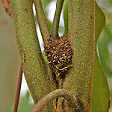 Dieback Borer Damage
Dieback Borer Damage
Dieback Borer (Platyomopsis armatula) adult is a grey-brown beetle up to 20mm long with small lumps on its wing covers and long antennae. The 15mm long cream coloured larva tunnel under the bark and feed on the sapwood causing ringbarking. The entrance to the tunnel is covered in frass and plants in the Myrtaceae family such as Eucalyptus species are susceptible.
Elm Twig Girdler (Oberea tripunctata). The adult beetle feeds on twigs causing girdling then deposits eggs during spring. The lava tunnels down the centre of the stem from the girdled point and overwinters in the tunnels. Twigs up to 14mm diameter may snap off at the damaged point and Ulmus species are normally the host.
Mahogany Shoot Borer (Hypsipyla grandella). The adult is a greyish-brown moth with a wingspan up to 45mm with the wings and veins distinctly overlayed in black. It deposits oval eggs that are tiny 0.50mm wide normally deposited in the leaf axil and change colour from white to red in the first 12 hours. In 3 to5 days the larvae emerges and can grow to 25mm long and is brownish white when young and maturing to bluish with a brown head capsule. Swietenia species are damaged as the larvae bore into the new shoots normally during spring or during the rainy season. The shoots and branches wilt then collapse. This is a major economic pest for cultivated trees.
Red Cedar Tip Moth (Hypsipyla robusta) adult is a grey moth with a wing span up to 20mm across and produces fleshy lava with true legs up to 20 mm long that tunnels into the tips of twigs. The tunnels are surrounded by webbing that is littered with pelleted droppings and is normally found on Toona species.
Staghorn Borer larvae grow to 15mm long and are greyish with true legs and the grey adult moth has a wingspan up to 20mm across. It attacks Platycerium species by eating tunnels into the sterile fronds.
Appearance and Distribution of the Pest
They are found mainly on the coast but also inland and are distributed by flying with the assistance of wind.
Life Cycle
These insects have a Holometabolous life cycle, ie. When metamorphosis is observed during the pupal stage.
Eggs are laid in bark on the growing tips. Larvae shelter in tunnels they create in the wood, up to 20mm deep.
Period of Activity
Active throughout the year in warm climates and are commonly found from tropical to sub-tropical and temperate regions.
Damage Caused
Generally the symptoms of tip borers is yellowing and curling of the leaves which wilt then die or shoots become blackened and are noticeable in the tree. Extensive feeding by a number of larvae causes dieback but normally, this is a minor pest.
The larvae emerge from their tunnels at night, to feed on the bark around the entrance holes. Entrance holes are covered by a layer of chewed wood fragments ("frass") and silk webbing. Most damage appears on twigs and new growth.
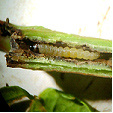 Typical larvae
Typical larvae
The Callistemon Tip Borer tunnels down the centre of the twigs causing then to die or break off and the Macadamia Twig Girdler (Neodrepta luteotactella) form tunnels in sapwood that are covered in fine webbing that is dotted in brown excreted pellets. This is the same appearance as the Banksia Web-covering Borer (Xylorycta strigata) larva makes, as it tunnels down the centre of shoots.
Susceptible Plants
Many native and ornamental plants are susceptible to tip borers such as Callistemon, Melaleuca, Banksia, Hakea, Macadamia and Stenocarpus species
Eucalyptus, Callistemon, Corymbia, Leptospermum and Melaleuca species are attacked by the Dieback Borer (Platyomopsis armatula). Twigs and small branches are attacked and the larvae causes ring bark. Affected branches break easily in high winds.
Sambucus, Yucca and Delphinium species are attacked the Common Stalk Borer (Papaipema nebris) which attacks the stems causing the plant to wilt and topple over.
Cultural Control
Larvae may be destroyed after exposure by pulling away the covering pad of frass, or by pushing a length of wire into the tunnel. Damaged branches may be removed, or tunnels plugged. Infested perennials or annuals should be removed and destroyed.
Biological Control
No effective biological control.
Chemical Control
Spray with Carbaryl (including the trunks or stems) if necessary while the insects are active.
Note
Always read the label for registration details and direction of use prior to application of any chemicals.
PEST
NAME
Longicorns, Long Horn Beetles
Various Longicorn Species
ORDER
Coleoptera
FAMILY
Cerambycidae
Description of the Pest
This is a large group of beetles with over 1,000 species that commonly have two long and conspicuous antennae and square shoulders. They may be large or small, dull or brightly coloured beetles. The creamy-white fleshy lava has reduced legs and taper from the thorax. Both the Lava and adult beetle has chewing mouth parts.
These insects have a Holometabolous life cycle, ie. When metamorphosis is observed during the pupal stage.


Appearance of the Pest
The adults lay eggs in wounds or in damaged areas by active borer larvae. The Larvae bore large circular tunnels in the sapwood for many months, which become packed with frass. The damage is evident with cracked bark, surrounded by sawdust and the appearance of gum oozing out of the wound.
Some species ringbark twigs or trunks and the larva pupate in the plant.
The adult emerges from 'emergence holes' and may chew bark or foliage but generally the damage is insignificant.

Auger Beetle (Bostrycnopsis jesuita) is another insect that produces a tunnel boring, plump white larva. The adult grows to 18mm long and its thorax forms an outgrowth that extends over its head making the beetle to always look down.
Pittosporum Longicorn (Strongylurus thoracicus) is brown with white spots on either side of the thorax with long antenna and is up to 30mm long. It lays creamy legless lava that feed on the sapwood of small branches in Pittosporum species by forming rounded tunnels.
Twig Girdling Longicorn (Platyomopsis humeralis) is a dark coloured beetle with anatine the same length as its body up to 20mm long. The wing covers may have stripes or dots and the mandibles are strong arranged at right angle to the body. It feeds on bark forming rings around branches or small twigs.
Period of Activity
The adults are active from spring to summer and are found throughout Australia from tropical to temperate regions.
Susceptible Plants
Many ornamental and Australian native trees, shrubs or climbers, including Eucalyptus, Pittosporum, Ficus and Vitis species. The larva also attacks recently fallen timber or existing dead plants.
Banksia species are attacked by the Banksia Longicorn (Paroplites australis) which is a reddish brown beetle to 50mm long with equal length antennae and produces a yellowish fleshy (grub-like) lava, that is legless and tapers towards its tail. It tunnels into the hardwood and can cause severe damage.
Eucalyptus are attacked by the Giant Longicorn (Eurynassa odewahni) which is a large beetle up to 80mm long with equally long antennae and produces a plump legless white (grub-like) lava, that are ribbed and tapers towards its tail.
Grevillea robusta, Melia azedarach and Brachychiton populneus are attacked by the Auger Beetle larva.
Damage Caused
The larva eats away the sapwood and may tunnel deep into the timber creating open wounds on the trunks and in some cases ring barking the plant. Certain species graze only on the bark and associated wood such as The Twig Girdling Longicorn and the result of the damage is not evident well after the insect has moved on. Branches that have been attacked are weakened and snap off during high winds.
The Auger Beetle eats circular holes through the sap wood and heart wood reducing the structural strength of the tree.

Cultural Control
Stressed plants are commonly attacked and action should be taken to invigorate the plant with additional watering and fertilising. It may be possible to kill the larvae with a piece of wire and areas that have been damaged should be treated with tree surgery techniques to mend the wound.
Biological Control
Beetles and larva are eaten by birds and lizards but are not an effective control.
Chemical Control
There is no effective chemical control.
DISEASE
NAME
Phytophthora Rot
Phytophthora species
Pathogen Name
A number of Phytophthora species cause these diseases but the most important species in Australia is the cinnamon fungus, Phytophthora cinnamomi. This species is exotic to Australia and probably originated from south east Asia; it has probably been present in Australia for close to 200 years. Phytophthora are fungal-like organisms that are related to some protozoa and algae; they are microscopic and cannot be observed by the naked eye.
Description
There are many types of Phytophthora Rot but generally the disease affects the plant by causing a soft rot of the affected plant part. The most common form of the disease is a rotting of the roots that occurs below ground with no visible symptoms of the disease above ground until the disease starts to cause leaf drop.
Symptoms
The disease is initiated below ground in the soil, usually on the feeder roots of a plant. The pathogen grows through the roots killing cells and eventually causing an extensive root decay. This causes the infected plant to lose vigour and the leaves to yellow and die. Entire branches starting from the top then die, quickly during hot weather or linger for months. The infection occurs on the root hairs causing small and large roots to rot. The symptoms of the disease are often very difficult to differentiate from drought symptoms, mainly because the affected root system prevents the uptake of moisture from the soil. Once the disease has progressed far enough large branches will die causing the typical dieback symptoms.
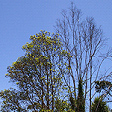
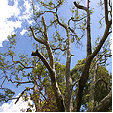
There are a number of other diseases caused by Phytophthora species
Twig Die Back (Phytophthora ilicis) attacks Ilex species causing black leaf spots and black stem cankers.
Phytophthora cactorum is known by several common names depending on which plant is being attacked and they have various symptoms. Plant species are listed below.
Root Rot (Phytophthora richardiae) infects Zantedeschia species causing the leaves to turn yellow, wilt and die. Flowers are deformed if they bloom and the infection can also be seen in the new growth, eventually killing the plant. On inspection the roots show signs of decay.
Stem Rot (Phytophthora cryptogea) infects the roots and stems turning them brown and seeds are also attacked causing decay. It is commonly found on Tagetes erecta and infected plants wilt, collapse and die.
Source and Dispersal
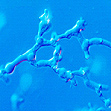 Sporangia
Sporangia 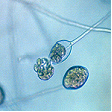 Zoospores
Zoospores 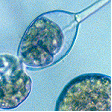
Image by Dr Brett Summerell
Phytophthora species produce sporangia that contain specialised zoospores that have flagella that allow them to move through the soil moisture small distances. These spores encyst on the root and then penetrate the root. The pathogen also produces chlamydospores, specialised survival spores that allow it to survive in the soil for extended periods of time. The chlamydospores can be transported in soil, even extremely small amounts, allowing the pathogen to be dispersed very easily throughout an area and from one location to another. The zoospores are easily moved in water flowing through soil and so are easily dispersed down slopes. It is not uncommon for the disease to move in fronts down a slope.

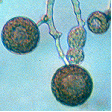 Chlamydospores, specialised survival spores
Chlamydospores, specialised survival spores
Image by Dr Brett Summerell
Favoured Conditions
Phytophthora root rot is favoured by poorly drained soils or in soils that are waterlogged for short periods of time. The disease generally occurs during periods when the temperature is above 16ºC although it has been observed in snow gum country in the Barrington Tops National Park and in southern Tasmania. It also prefers soils that have little organic material.
Affected Plants
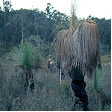
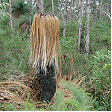 Xanthorrhoea species
Xanthorrhoea species
Image by Dr Brett Summerell
The host range that is attacked by Phytophthora cinnamomi is enormous and is still not well understood but includes many Australian native plants, Rhododendrons, Acer and Prunus species, conifers, cabbage tree and strawberries. Some Australian plant families that are quite susceptible include species in the Proteaceae, Epacridaceae and Xanthorrhoea species.
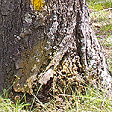 Alphitonia excelsa
Alphitonia excelsa
Alphitonia excelsa can be infected by Phytophthora cinnamomi causing loss of foliage, death of the upper branches and cankers on the trunk.
Cactus such as Cereus species may be infected with Slimy Collar Rot (Phytophthora cactorum) which forms a soft black area at the base of the plant that is water soaked.
Chamaecyparis species may be infected with the Root Rot (Phytophthora lateralis) that attacks roots, trunk, stems and leaves.
Cornus species are infected by Crown Canker (Phytophthora cactorum) and in this case the tree is partially infected initially with one side producing smaller leaves that turn reddish in late summer. The leaves may also shrivel and die prematurely, during dry periods and small and large branches die. After a couple of seasons the tree becomes completely infected with poor top growth and an inconspicuous canker develops at the base of the trunk. Eventually the tree dies.
Erica species are infected by (Phytophthora cinnamomi). The symptoms include foliage turning greyish towards the top, and then the plant wilts then dies with evidence of infection at the base.
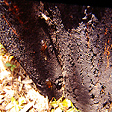 Phytophthora in Eucalyptus species
Phytophthora in Eucalyptus species
Image by B. Sonsie
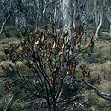
Image by Dr Brett Summerell
Eucalyptus species are infected by Phytophthora cinnamomi causing rapid die back of the tree with blackened trunk loss or upper growth and is a serious problem for certain species such as Eucalyptus diversicolor (Karri).
Euphorbia pulcherrima is susceptible to Root Rot (Phytophthora and Pythium species). Roots become dark and the rot can extend up the stem. The plant is also susceptible to leaf blight resulting from the same fungal disease.
Hedera species are infected by Phytophthora Blight (Phytophthora palmivora). This fungus causes leaf spots, foliage blight and stem rot.
Palms such as Archontophoenix, Caryota, Chamaedorea, Cocos, Dypsis, Howea, Liculia, Linospadix, Livistona, Phoenix, Ptychosperma, Rhapis, Roystonea, Syagrus, Washingtonia and Wodyetia species are also susceptible to Phytophthora Blight forming large irregular areas on the fronds that become dark and rotten and limited by the veins
Lilium species are infected by Foot Rot (Phytophthora cactorum) which attacking the stems just below the soil level causing the plant to topple and if infection occurs as the leaves are emerging the base of the infected leaves which collapse remain attached to the bulb.
Morinda citrifolia is infected by Phytophthora Blight, black flag disease (Phytophthora species) which causes the foliage to turn black and limp. The fruit and stems are also infected causing them to turn brown-black and whither.

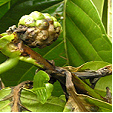 Morinda citrifolia
Morinda citrifolia
Orchids such as Cattleya, Cymbidium, Cypripedium, Dendrobium, Epidendrum, Paphiopedilum, Phalaenopsis and Zygopetalum species are infected by Black Rot (Phytophthora or Pythium species). This causes the leaves, pseudobulbs, rhizomes and roots to form a dark soft rot, normally occurring towards the base of the plant.
Saintpaulia, Dianthus, Gypsophila, Limonium and Anemone species are infected by Root and Crown Rot (Phytophthora nicotianae). This is a fast moving fungus that turns the roots blackish then extends to the crown and petioles causing wet rot of the crown then wilting, eventually killing the plant. When found as Phytophthora Leaf Spot or Blight, angular spots appear with water-soaked margins as in Cordyline and Philodendron species.
Sedum species can be infected by up to three Stem Rot fungi including (Colletotrichum species), (Phytophthora species) and (Pellicularia filamentosa). Commonly occurring in wet soils.
Ulmus and Acer species are also infected by (Phytophthora cactorum) and this is known as Bleeding Canker. This casual disease initially causes cankers in the bark that ooze sap and the sapwood forms reddish lesions with greenish margins. The leaves on affected branches turn yellow, wilt then die and mildly affected trees may survive.
Many species are infected by the Bleeding Canker including Acer platanoides, Acer rubrum, Acer pseudoplatanus, Acer saccharinum, Betula species, Liquidambar styraciflua, Aesculus x carnea, Tilia, Salix and Quercus species.
Non-chemical Control
The most effective control for all Phytophthora diseases is prevention primarily because it is extremely difficult to control Phytophthora diseases after they are established in the plant. As Phytophthora species are most easily transported in infested soil quarantine is an essential component of control of the disease and it is for this reason many areas have hygiene protocols to stop the pathogen being introduced into an area. It is recommended that bush walkers take care not to introduce the pathogen on their boots into un-infested areas and for this reason it is suggested that walking boots be cleaned and preferably sterilised (with 70% methylated spirits) prior to starting a walk.
Cultural techniques such as cultivating the soil regularly with added animal manure and other organic substrates to ensure there is good drainage will also help to minimise the impact of the disease. The plants can be mulched with straw or other organic material taking care that the base of the trunk is left clear. Avoid over watering the soil and observe hygiene in regards to tools, containers or shoes to reduce spreading the infection.
Potting mixes should be pasteurised for 30min at 60ºC to ensure that they are free of the pathogen. It is also very important to grow pots off the ground to prevent the splash of infested mix or water from an infected plant to clean plants.
.
Avoid damaging the bark particularly at ground level and seal any wounds that occur. If cactus or tree species are infected it is possible to cut out the infected area when first seen in order to contain it. Correct tree surgery techniques are required for large trees.
Chemical Control
There are a number of fungicides that are registered for use in the control of these diseases. The most effective chemical control are based on the use of chemicals containing potassium phosphonate. This chemical effectively enhances the defence systems of the plant and has been shown to be most effective in controlling Phytophthora diseases. It is essential that the chemical be applied when the plants is exporting nutrients to the roots, so this is best in the warmer months. The chemical can be applied as a stem injection or a foliar spray, and in some situations as a soil drench. There are specialised stem injecting equipment available for stem injections on larger trees.
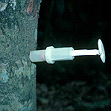
Image by Dr Brett Summerell
Note
Always read the label for registration details and direction of use prior to application of any chemicals.
Amendments by
Dr Brett Summerell
Director Science and Public Programs
Royal Botanic Gardens Trust, Sydney
Average Lowest Temperature : -5º C 23º F
USDA : 9, 10
This USDA (United States Department of Agriculture) hardiness zone chart can be used to indicate a plant’s ability to withstand average minimum temperatures. However, other factors such as soil type, pH, and moisture, drainage, humidity and exposure to sun and wind will also have a direct effect on your plant’s survival. Use this chart only as a guide, always keep the other factors in mind when deciding where, when and what to plant.
A plant's individual USDA zone can be found in the Plant Overview.
Region of origin

Australia (south west Western Australia)
Climate Description
Cool Temperate
This zone has low winter temperatures and moderate summer temperatures with low humidity and cool nights. Frosts are severe with snow at higher altitudes.
Drought rarely occurs and wind is cold inland or wet on the coast.
Plant growth
Cool weather plants grow well.
| Dictionary | Growth Habit |
| Leaf Type | Botanic Flower Description |
| Leaf Shape | Flower Inflorescence |
| Leaf Arrangement | Fruit Type |
| Leaf Margin | Bark Type |
| Leaf Apex And Bases | Flower Description |